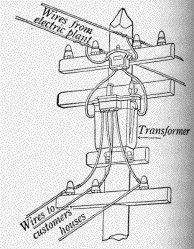|
(E11) The Reason for Using Alternating CurrentThe use of AC makes the transmission of electrical power to great distances much more economical. Suppose we need to transmit power W (watts, or more likely megawatts, millions of watts) from the power station where it is produced (by steam turbines or water turbines) to distant users. To make things simple, assume that all currents or voltages are DC (or else, if this is AC, replace them by their r.m.s. values, which leads to the same expressions for power) and ignore the resistance of the return portion of the current. 
If the distance (drawing below) is great, the cables connecting the two may be quite long, and may have a fair amount of electrical resistance R.
The total power delivered by the power station is ("twinkle, twinkle little star, power equals I squared R"). That power is a net loss to the customer, whose voltage (by Ohm's law, applied to that part of the circuit) is now diminished by and the user does not get the full supply voltage V, only V –V'. Obviously, the power company would like to make W' as small as possible. One obvious way is to reduce R--make the power wire thicker. But there exists an economic limit: thicker cables use more copper and cost more, and they are also heavier, making it hard to suspend them from slender towers, widely spaced. But suppose one could somehow change both the voltage V and the current I without changing the rate W at which electric power is provided--say, increase V until it is 1000 times larger, while I becomes 1000 times smaller. The power IV delivered is then the same as before, but the power loss W' = I2R is reduced a million times! True, the power lines may find it harder to prevent leaks from an "electric pressure" V that is 1000 times greater. Such a problem could well exist with water pipes! However, as already noted air is an excellent insulator and even voltages of 110,000 volts and more can be transmitted along power lines hanging in the open. Only the insulators which hold those wires need to resist a higher voltage--e.g by shaping them as a long stack of ceramic plates which sheds off rainwater. It is also true that the voltage must be "stepped down" back to 110 volts before entering the home: wires hanging high above the ground may hold back very high voltages, but wires in homes and factories are wrapped in thin plastic and inside one's walls, safe at 110 volts but not voltages many times larger. Still, it remains an attractive idea. Can it be done? Not with DC. However, it turns out that AC allows such exchanges--raise the voltage, lower the current--by means of devices known as electric transformers. Power companies all over the world use this trick. Transformers at the power station step up the voltage to 100,000 or 200,000 volts (sometimes even more), and well-insulated "high voltage lines" carry the power across the country, with high V but small I. 
Then at the destination the voltage is again stepped down, usually in several steps; transformers do so quite efficiently and consume very little power (which is just as good--if they absorbed energy, they would get too hot). The process ends with fairly small transformers, each supplying a block of apartments, a small group of dwellings or perhaps a single factory or farm; some can be seen attached (with input and output wires isolated by ceramic insulators) to the top of the poles that carry electric supply lines (image from "Principles of Physics" by Millikan and Gale, 1927). Often they are encased in (electrically grounded) metal containers filled with oil, which insulates electrically but helps carry away whatever heat is generated. On the History of ACThe first public electricity system was devised by Thomas Alva Edison in the 1880s and used direct current. Electricity was not widely used--mainly for providing light (using Edison's lightbulb or its improved versions) and primarily in cities where distances were small. Long-distance telegraph used batteries. George Westinghouse, aided by the Serbian engineer Nicola Tesla (reluctantly followed later by Charles Proteus Steinmetz at General Electric which Edison helped start), realized that with AC, long distance transmission lines could operate at higher voltage, transmitting energy much more economically. Tesla also introduced polyphase AC, where the same generator created several related AC waves, a more efficient scheme. Around that time electric motors were entering wide use--in industry and on trolley cars--and ultimately AC prevailed, after a nasty publicity "war of currents" between Edison and Westinghouse. See
You may also look up an exchange of correspondence Who Invented AC?
|